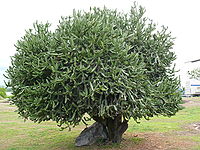Euphorbia lactea
| {{{name}}} LATINNAME
|
'
| ||||||||||||||||||||||||||||||||||||||||
|---|---|---|---|---|---|---|---|---|---|---|---|---|---|---|---|---|---|---|---|---|---|---|---|---|---|---|---|---|---|---|---|---|---|---|---|---|---|---|---|---|---|

|
|
| |||||||||||||||||||||||||||||||||||||||
| |||||||||||||||||||||||||||||||||||||||||
| Standard Cyclopedia of Horticulture |
|---|
|
Euphorbia lactea, Haw. (E. havanensis, Hort., at least in part). Fig. 1445. Similar to E. antiquorum, but with a white-marbled area running through the middle of each face of the branches. E. Indies.—One of the most common succulent euphorbias in cult., of fine candelabra form, and making rapid growth. The euphorbias grown for hedges in Fla., W. Indies, etc., are chiefly this species, though some may be E. antiquorum. It is often confused with E. Hermentiana. Cristate forms are in the trade as E. lactea monstrosa and E. havanensis cristata, though these should perhaps be referred to E. antiquorum. CH
|
Cultivation
- Do you have cultivation info on this plant? Edit this section!
Propagation
- Do you have propagation info on this plant? Edit this section!
Pests and diseases
- Do you have pest and disease info on this plant? Edit this section!
Species
Gallery
If you have a photo of this plant, please upload it! Plus, there may be other photos available for you to add.
References
- Standard Cyclopedia of Horticulture, by L. H. Bailey, MacMillan Co., 1963
External links
- w:Euphorbia lactea. Some of the material on this page may be from Wikipedia, under the Creative Commons license.
- Euphorbia lactea QR Code (Size 50, 100, 200, 500)

